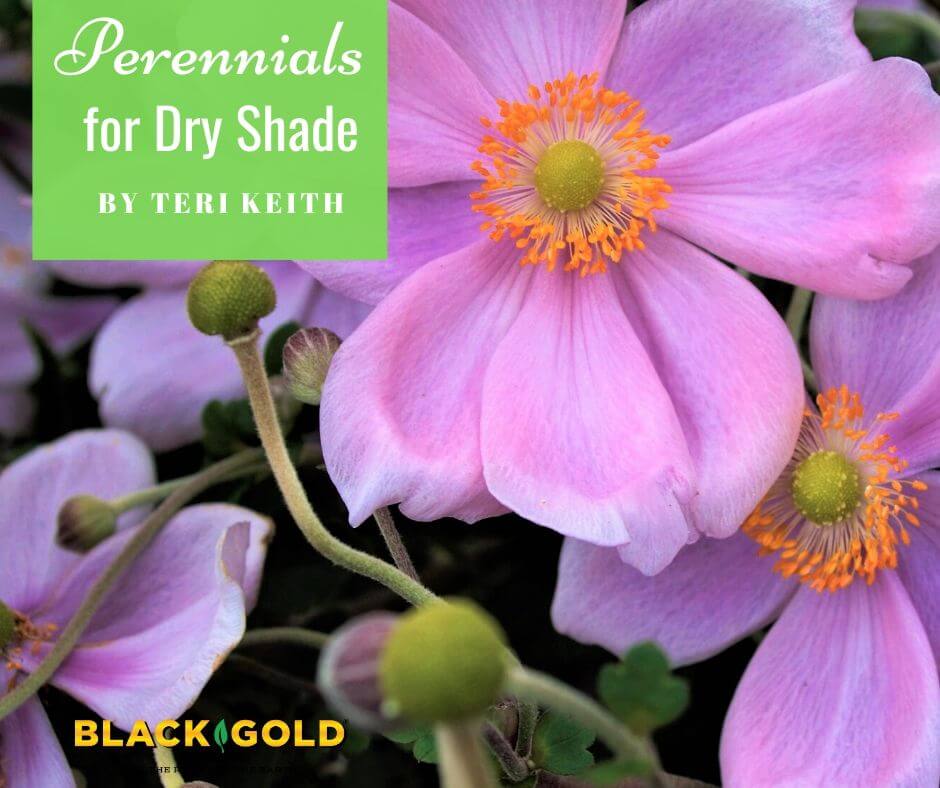
Here in the Midwest, we have had unusually dry weather from August to October in the past few years. Last year we had no rain, except for one sprinkle, for ten weeks. My water bills exceeded $200, with the water company calling me to ask if we had a leak somewhere. I had the sprinkler on often moving it every two hours to a new spot, to save my extensive gardens, shrubs, and trees.
Still, the gardens remained dry, which has inspired me to consider new ways to save water in the garden (click here for some good ideas). I did, however, notice that some perennials fared better than others in the shade garden, even under my large silver maples (Acer saccharinum). Here are several I recommend if you garden in shady areas that have the potential to become seasonally dry.
Barrenwort for Dry Shade
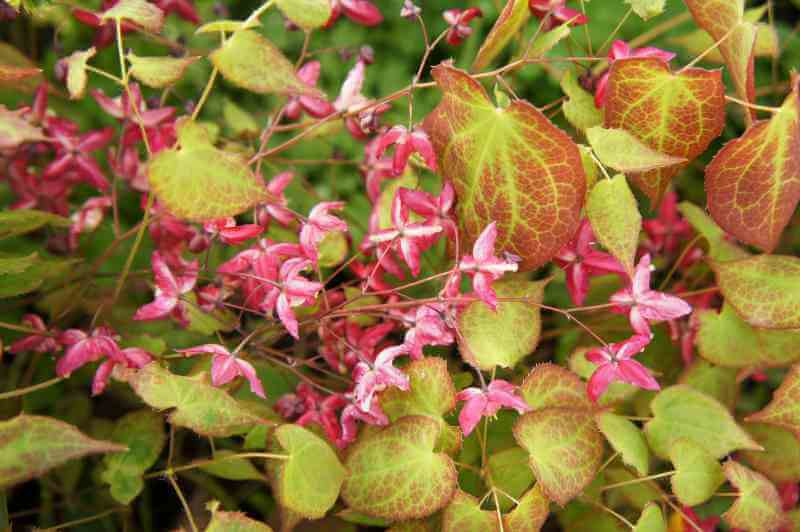
Barrenwort (Epimedium spp.) is a slow-growing, spring-flowering perennial for shade gardens with attractive foliage that withstands dry shade through summer and fall. Growing only 8 to 15 inches tall, depending on the type, it has small, heart-shaped or elongated leaves, often with darker edges or colorful veins. The unusual, pendulous flowers appear on slender stalks and are small and four-petaled. They come in several different colors, including ivory, orange, pink, red, and yellow.
I have fairy wings (Epimedium grandiflorum, USDA Hardiness Zones 5-7) with red-lilac flowers, ‘Orange Queen’ (Epimedium x warleyense ‘Orangekönigen’, Zones 5-9) with orange flowers, and ‘Sulphureum’ (Epimedium × versicolor ‘Sulphureum‘, Zones 5-9), my favorite, with yellow flowers. The red-flowered bishop’s hat (Epimedium x rubrum, Zones 5-9) is another reliable variety that also boasts reddish-tinged foliage. These are very easy to grow, noninvasive plants, and the leaves are attractive all season.
Helleborus for Dry Shade
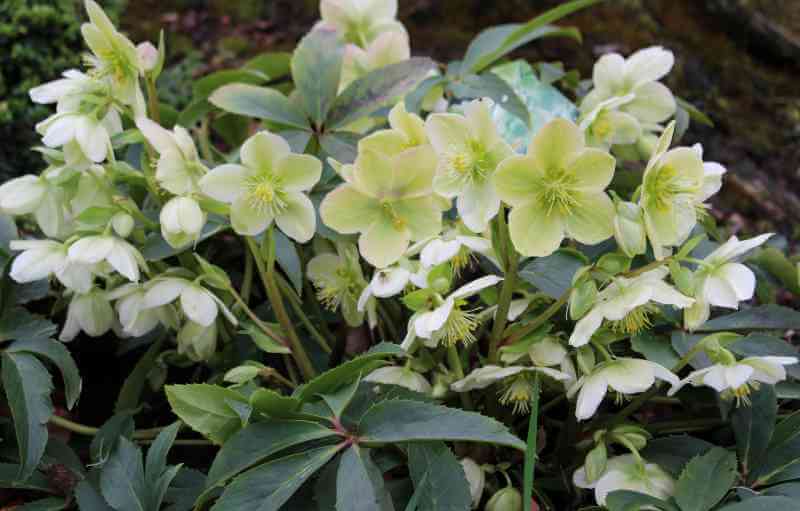
Lenten rose and Christmas rose (Helleborus orientalis, Zones 6-9, and Helleborus niger, Zones 3-8) are among the earliest bloomers with the Christmas rose blooming a little earlier than Lenten. When it is still cold, they display their beautiful single or double flowers, letting you know that spring is coming. Most varieties have 3 -to 4-inch-wide flowers, in shades of pink, ivory, dark rose, green, or black; many of the light-colored flowers have freckles. Lenten roses have evergreen, palm-shaped leaves that look pretty all year round, even in dry shade. The plants stand 1 to 2 feet tall. A warning, they are poisonous, especially the roots, so refrain from planting them in areas where small children and pets frequent. (Click here to learn more about growing hellebores.)
Geraniums for Dry Shade
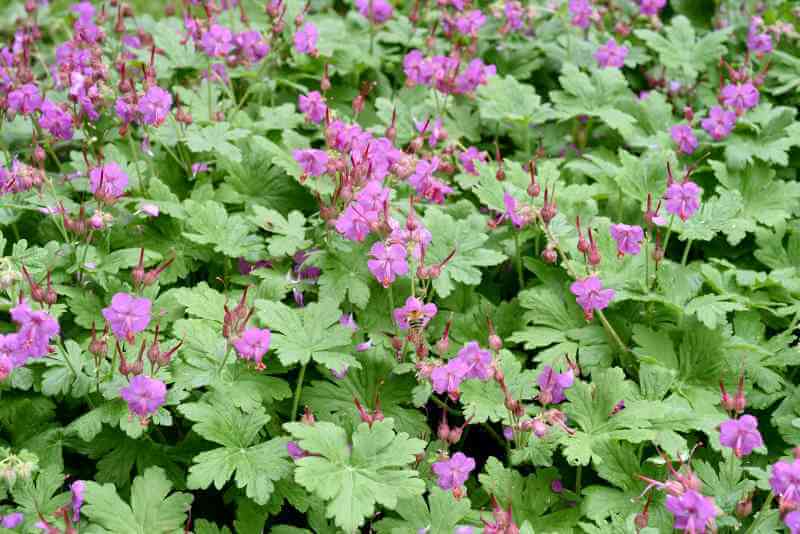
Perennial geraniums are not related to Pelargonium, the annual geraniums you buy every spring. The perennial types, called cranesbills, are quite hardy and long-lived once established. One of my favorites for shade is the big root geranium (Geranium macrorrhizum, Zones 3-8), which is a mounding plant that flowers from spring to fall and has large, water-holding roots to help it ward off dry spells. While the mound can typically get 20 inches tall, some are shorter with centers only reaching 12 inches tall with a 24-inch spread. The delicate single blooms can be violet, blue, lavender, or light- to rose-pink. To keep them reblooming, cut back the stems. It also helps to cut back older leaves when they start looking ragged. This year I bought a beautiful new variety, ‘Elke’, with bright pink flowers edged and centered with white.
Anemones for Dry Shade
Japanese Anemones (Anemone x hybrida, Zones 4-8) are one of my favorite dry shade flowers. They start showing their wide blooms in August and keep blooming until frost on tall stems that sway in the breeze. Colors range from white to dark pink and purple. Some excellent varieties are the white-flowered ‘Honorine Jobert’, double, dark-pink-flowered ‘Bressingham Glow’, and double, pink ‘Margarete’. They will slowly spread via underground runners.
I also have the native spring-flowering Virginia anemone (A. virginiana, Zones 3-8) under my silver maple, and it thrives in the dry shade there. It bears white flowers in mid- to late-spring and feathery foliage through summer. Its one downfall is that it tends to spread, so it needs space.
Pulmonarias for Dry Shade
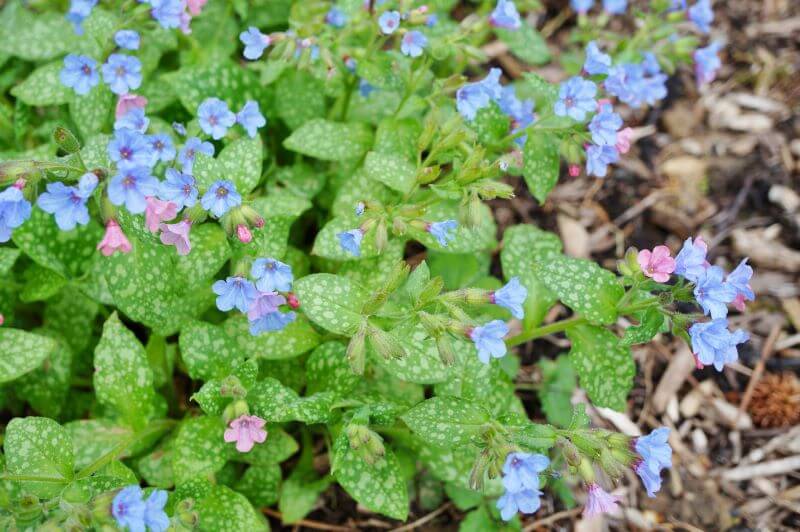
Lungworts (Pulmonaria spp.) are low growing plants that are grown for their spotted leaves, as well as their pinkish and violet-blue flowers. The unfortunate name arose in the Middle Ages because its spotty leaves look lung-like. At that time, it was believed that the pattern or shape of a plant’s leaves indicated it would be good to use as a medicine for organs it resembled.
Pulmonarias only 12-14 inches tall, including the flower spikes, and grow slowly to 2 feet wide. The pretty spotted or mottled leaves can be silvery or white with flowers ranging from glowing rose, blue, purple, and white. They cannot tolerate the sun, which will fry the leaves, but established plants can take dry shade. Look for ‘Raspberry Splash’ with intense pink flowers and dotted leaves, ‘Silver Bouquet’ with silver leaves and rose and blue flowers or ‘Bertram Anderson’ with silver blotched leaves and glowing blue blooms.
Other Perennials for Dry Shade
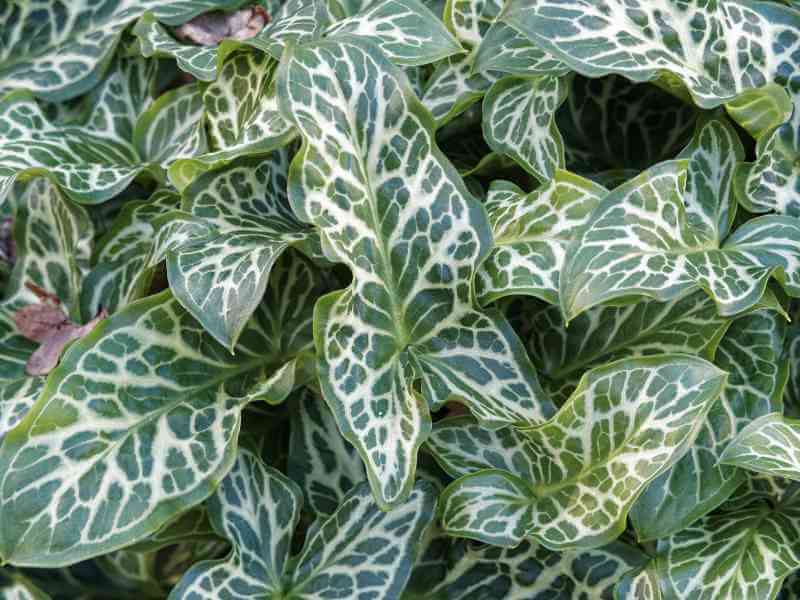
When my daughter was studying horticulture at Purdue University, she brought home an Italian arum (Arum italicum, Zones 5-9), which forms an interesting clump of attractive leaves that withstand drought. It is a beautiful plant whose insubstantial flowers develop bright orange-red fruits late in the season.
Christmas fern (Polystichum acrostichoides, Zones 4-9) dots the dry woods in our region and also makes an outstanding fern that will grow well in dry, shaded gardens. Its evergreen fronds look good all winter when not covered in snow (click here to read more about evergreen ferns).
Evergreen European wild ginger (Asarum europeaum, Zones 4-7) is another good foliage plant that will take dry periods in summer and continues to look pretty all season with its glossy, heart-shaped leaves.
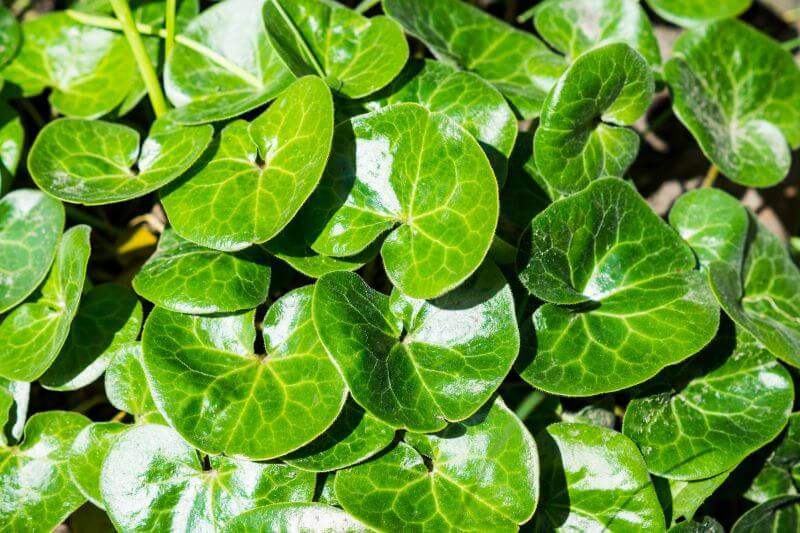
Of course, all plants will require some watering if it has been three weeks since it has rained, but there are two things you can do to help with hot, dry weather. First, fortify garden soils with Black Gold Canadian Sphagnum Peat Moss, which helps to hold moisture in the soil when conditions are dry, and mulch, which keeps the soil moisture from evaporating. When planting, remember to sprinkle a time-released fertilizer over the plants, and again in early July to keep them looking good until frost.
When you do need to water your garden, shrubs, or trees, 1 inch a week should do the trick. Leaving them completely without irrigation during the hottest, driest periods of summer and fall will result in poor looking shaded beds.


